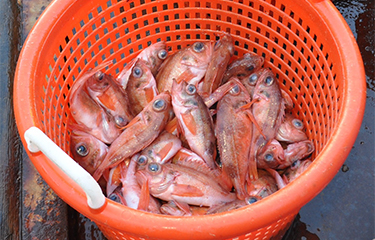The New England Fishery Management Council has approved groundfish catch limits for the 2024 fishing year in the Northeast U.S., with deep cuts made to multiple species and few increases.
The sub-annual catch limits (sub-ACLs) for multiple species of groundfish were decided through Framework Adjustment 66 to the Northeast Multispecies (Groundfish) Fishery Management Plan (NEFMC), which was implemented nearly forty years ago to reduce mortality of heavily fished groundfish stocks and promote rebuilding to sustainable biomass levels, and will still require approval from NOAA. In addition to setting quotas for multiple species in 2024, the new framework adjustment also includes provisions that will affect 2025 and 2026.
Across almost every species, NEFMC recommended cuts to the catch limits, with Georges Bank haddock seeing one of the largest cuts of any species. The council recommended a sub-ACL of 6,570 metric tons (MT), a decrease of 41 percent from the 11,080 MT limit applied in FY 2023.
Meanwhile, the Gulf of Maine fishery gained haddock quota, as NEFMC recommended a sub-ACL of 1,435 MT – an increase of 19 percent over the 1,208 MT granted last year.
The Gulf of Maine emergency action, though, will see a decrease of 9 percent from 1,569 MT to 1,435 MT. NEFMC petitioned NOAA for an emergency action earlier this year to boost the TAC of haddock in the Gulf of Maine in order to avoid early shutdowns. Anecdotal evidence from fishers said they were encountering haddock in large numbers, and some said they were actively avoiding them.
“Who’s overfishing? We’re down to about 17 active boats in the New England groundfishing fleet,” Jerry Leeman, a groundfish fisherman and founder of the New England Fishermen Stewardship Association, said. “Landings are low because no one is bothering. I’m seeing them up and down the seaboard. We run away from the damn things because it costs us financially to catch them. You have to be on top of your game and stay away.”
Georges Bank and Gulf of Maine cod, meanwhile, saw minor increases in sub-ACL. Georges Bank cod increased 3 percent to 386 MT from 375 MT, and Gulf of Maine cod increased to 281 MT – up just 1 percent from 279 MT.
Cod is currently under a new rebuilding plan implemented after a massive collapse of the fishery occurred during the 2010s. Landings in the early 2000s were as high as 4,500 MT, but that level dropped precipitously and hit just 36 MT in 2017.
The quota for Acadian redfish will also drop in 2024. NEFMC allocated 7,891 MT of quota for 2024, down 17 percent from the 9,469 MT allocated in 2023. An assessment of the species found that it is currently not overfished.
Pollock – the most-caught species by volume – is also receiving a reduction in its sub-ACL. NEFMC reduced the catch by 7 percent to 12,183 MT – down from 13,124 MT in 2023.
Another species seeing large cuts is yellowtail flounder. The sub-ACL for the species in Georges Bank dropped 33 percent to just 56 MT, down from 84 MT in 2023. Gulf of Maine yellowtail flounder, meanwhile, dropped 11 percent to 876 MT – down from 985 MT.
Another key cut for yellowtail flounder is to the allowable catch limit granted to the sea scallop fishery. Scallopers are now only allocated 11 MT of yellowtail flounder bycatch in Georges Bank, down 33 percent from 16.5 MT.
The scallop fishery is also facing a reduction in its sub-ACL for windowpane flounder in the Gulf of Maine and Georges Bank, as well as the Southern New England and Mid-Atlantic. For Gulf of Maine/Georges Bank windowpane flounder, the fishery will have a sub-ACL of 26.6 MT, down from 31 MT. For Southern New England and the Mid-Atlantic, it will have a sub-ACL of 71.3 MT, down 45 percent from the 129 MT it had in 2023.
The scallop fishery faces reactive accountability measures (AM), triggered when it exceeds the sub-ACL for either type of flounder. The current AM requires modified dredge gear when fishing in scallop fishing Area II, and according to a release from the council, that AM will “likely be in place in fishing year 2024” due to continued overages of windowpane flounder.
There is some good news for the scallop fishery, as Framework 66 includes a temporary modification to the trigger for the accountability measures on Georges Bank yellowtail flounder; it will only go into place if the scallop fishery exceeds its sub-ACL in Georges Bank and the overall sub-ACL is also exceeded by the fishery.
However, given the fishery has already seen overages for windowpane flounder, that modification won’t do much, NEFMC Spokesperson Janice Plante told SeafoodSource.
“The scallopers already exceeded their windowpane flounder for the past couple years, and it looks like they will this year,” Plante said. “So, they’re already operating under this AM.”
That means scallopers will be using alternative dredge gear regardless of their impact to yellowtail flounder.
Plante added the council has made it a priority in 2024 to review the yellowtail flounder sub-ACL and the AM triggers that impact the scallop fishery. In 2021, the scallop fishery was only allowed 12 MT of bycatch but ended up catching 29.1 MT – an overage of 242 percent.
“The council set how we deal with these accountability measures as a 2024 priority,” Plante said. “We’re going to be working on that for the whole next year ahead because it’s hard to just give them 12 MT, or 9 MT a year, when there are flatfish on the bottom when you go scalloping.”
Historically, over the last five years, the U.S. fishery has never managed to catch even one-third of its total allowable catch for flounder in the targeted fishery.
One of the few species that saw almost no change to its quota was white hake. The species received a sub-ACL of 1,828 MT in 2024 – up just slightly from the 1,826 MT limit in 2023.







